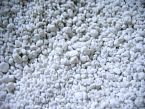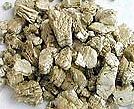Art Concrete How-to
1: Materials
THIS PAGE is one of several explaining techniques about how to use concrete in small-scale art projects.
| Book: Concrete Handbook for Artists: Technical Notes for Small-scale Objects. More information? |
Concrete is a mix of portland cement, aggregates, water and other optional additives that give the mix certain characteristics.
PORTLAND CEMENT:
Portland cement is what holds the aggregates together and is available in different grades and colours. The type you can buy at the local hardware or lumber store is grey in colour. White portland cement has the tetracalcium aluminoferrite removed, resulting in a pure white powder, with no loss of strength. It is more expensive.
AGGREGATES:
STONE:
Crushed stone or gravel can range in size from 1/4" to 1". For small-scale sculpture you probably won't need any larger than 1/4" or 5mm. You may not need it at all unless cost is a factor: stone is cheaper than cement. Stone adds strength to larger work.
SAND:
Sand should be "sharp", that is have sharp edges, so that the crystals of cement grab it. It is usually called sharp sand, brick sand or mortar sand. The grains of pit run sand or beach sand are usually too round.
FINE:
Stone dust, a waste product from quarries or stone works, can be added to smooth mixes for small-scale work. It adds strength, reduces shrinkage on setting, and may add to the visual appearance of the concrete. Limestone or marble dust are two types of stone dust.
Supplementary cementitious materials. L-R: fly ash, metakaolin, silica fume, fly ash, slag, and calcined shale. Image courtesy Portland Cement Association.
EXTREMELY FINE:
SILICA FUME:
Another waste product, this admixture is from metal smelting. It is a very fine dark grey powder. Particle sizes are 1/100 the size of portland cement particles. If used in the right proportions (about 8% by weight of the portland cement) it can double the compressive strength of the concrete, reduce permeability, increase density. It can be difficult to handle as it is very fine, and makes the wet mix "sticky".
METAKAOLIN:
Metakaolin (used at about 8% by weight of the portland cement) can double the compressive strength of the concrete, lowers permeability and increases density but also has advantages over silica fume. Metakaolin makes the mix creamier, less sticky, and is a plain white in colour. Particle size is smaller than cement but bigger than silica fume. Metakaolin is a fairly new additive and may be difficult to find. (Try distributors of plastering materials for the pool industry.)
LIGHTWEIGHT:
PERLITE, VERMICULITE, PUMICE:
Naturally occurring minerals that expand when heated. Perlite is white and crispy, vermiculite is darker. Pumice is a volcanic (glass) rock.
POLYSTYRENE BEADS:
Difficult to mix in and messy to use (static cling and very lightweight) - it is best to use coated beads. There is a dry pre-mix available in large quantities via foamliteconcrete.com
 PLASTIC FIBRES:
PLASTIC FIBRES:
Fibre additives, such as FiberMesh and Fiber Ad (polypropylene) are chopped (about 1/2", 1 cm) strands of plastic. They disperse into the wet concrete mix and help prevent shrinkage cracks as the concrete sets. Shrinkage cracks can later cause problems. On a very small scale the fibers also add a small amount of tensile strength. They are almost invisible in the final product. A new fibre called PVA or polyvinyl alcohol, has a much greater bond with the cement and therefore a much higher tensile strength. Note: You cannot use a polymer additive such as latex or acrylic with PVA fibres or that bond is weakened.
 GLASS FIBRES:
GLASS FIBRES:
Glass fibres added to the concrete mix must be alkali resistant, or the alkalinity of the cement will eventually break them down. Their purpose is to add tensile strength to the concrete, replacing steel reinforcing in special circumstances. This makes them a useful addition for art work where the concrete might be cast in a space where steel reinforcing could not be used. The coated fibres, such as Cem-FIL, are usually 12 mm long, and are added after the wet mix is ready. Also available as a mesh or cloth (see image).
STEEL REINFORCING:
Steel is the most commonly used reinforcing to give concrete tensile strength. In construction projects it use used as rebar, 1/2 to 1" rod. Smaller art projects can use much thinner steel rod. There are also varieties of galvanized steel meshes or screens available. One type of expanded steel mesh is used as a stucco base and can be cut with metal snips (carefully). There are other square grid galvanized meshes, 1/4", 1/2" and so on. Chicken wire, used for fencing, is also a flexible and easy to use material.
AIR ENTRAINERS:
Air entrainers are used in concrete that may be exposed to frost, or repeated freeze-thaw cycles. They work by creating tiny air bubbles in the wet mix. MicroAir is one brand. Very small quantities are used.
SUPER PLASTICIZERS:
In mixing concrete you try and get all the dry particles in the mix to be wetted. The aim is to use as little water as possible, because water not chemically combined stays in the dry mix and causes weakness. Plasticizers help to wet the surfaces, enabling the mix to use less water. One brand is Pozzolith. Tiny amounts are used. It is also called a "water reducer."
LATEX OR ACRYLIC:
Latex or acrylic additive (or admixture) is sometimes used in concrete, adding it to the water first. It acts as a plasticizer (to use less water), increases strength and makes it more waterproof, and increases adhesion (for example, when adding a surface to an older piece of concrete).
PIGMENTS AND DYES:
Pigments or dyes can be added to the mix, or applied to the surface of set concrete. Special dyes are made for this purpose as common pigments can be broken down by the alkalinity of the cement. The range of colours are in the earth tone range: black, grey, brown, ochre, dark red. Blues and greens are available but costly for large projects. Pigments are available as liquids, or as powders. Concrete can also be surface coloured with acid stains or opaque stains made for outdoor use. The latter has a wide range of colours, but some may not be long-lasting.
SEALERS:
In some circumstances it is advisable to seal the concrete surface to reduce water penetration, which aids frost resistance and resists acid rain.
ACRYLIC:
Most of the readily available sealers are acrylic-based. Some may affect the surface finish leaving it glossy and they may yellow slightly over time, and need renewing if used outside.
SILOXANE:
Silane or siloxane sealers combine chemically inside the concrete leaving a natural surface. Siloxane does not change the surface appearance of the concrete. The solvents in these sealers demand a lot of ventilation.
POTASSIUM OR SODIUM:
Potassium silicate or sodium silicate (water glass) water-based sealers work by chemically combining with the free limne or excess alkalinity of the cement mix. They form a gel which hardens and consequently densifies the concrete, decreasing the moisture permeability and porosity. The concrete can be damp (not wet) when it is applied. If the concrete is bad quality or very porous this sealer may not work well and you might be better off with the older acrylic or vinyl sealers.
| Home | HOW-TO | Materials | Small Scale | Mesh | Casting | Colour | Hazards | Books | Sources | Shapecrete |
CONTACT + LEGAL
Last update: 2016.



